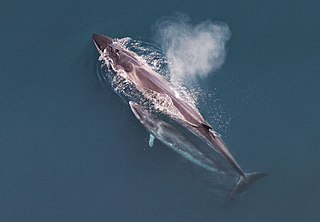
Corona Borealis is a small constellation in the Northern Celestial Hemisphere. It is one of the 48 constellations listed by the 2nd-century astronomer Ptolemy, and remains one of the 88 modern constellations. Its brightest stars form a semicircular arc. Its Latin name, inspired by its shape, means "northern crown". In classical mythology Corona Borealis generally represented the crown given by the god Dionysus to the Cretan princess Ariadne and set by her in the heavens. Other cultures likened the pattern to a circle of elders, an eagle's nest, a bear's den, or even a smokehole. Ptolemy also listed a southern counterpart, Corona Australis, with a similar pattern.

The northern shrike is a large songbird species in the shrike family (Laniidae) native to North America and Siberia. Long considered a subspecies of the great grey shrike, it was classified as a distinct species in 2017. Six subspecies are recognised.

The sei whale is a baleen whale, the third-largest rorqual after the blue whale and the fin whale. It inhabits most oceans and adjoining seas, and prefers deep offshore waters. It avoids polar and tropical waters and semi-enclosed bodies of water. The sei whale migrates annually from cool, subpolar waters in summer to temperate, subtropical waters in winter with a lifespan of 70 years.

The northern right whale dolphin is a small, slender and finless species of cetacean found in cold/temperate waters of the North Pacific Ocean. It is one of two species of right whale dolphins.

Alpha Coronae Borealis, officially named Alphecca, is an eclipsing binary star in the constellation of Corona Borealis. It is located about 75 light years from the Sun and contains two main sequence stars, one class A and one class G.

Musca Borealis was a constellation, now discarded, located between the constellations of Aries and Perseus. It was originally called Apes by Petrus Plancius when he created it in 1612. It was made up of a small group of stars, now called 33 Arietis, 35 Arietis, 39 Arietis, and 41 Arietis, in the north of the constellation of Aries.

Pandalus borealis is a species of caridean shrimp found in cold parts of the northern Atlantic and northern Pacific Oceans, although the latter population now often is regarded as a separate species, P. eous. The Food and Agriculture Organization refers to them as the northern prawn. Other common names include pink shrimp, deepwater prawn, deep-sea prawn, Nordic shrimp, great northern prawn, northern shrimp, coldwater prawn and Maine shrimp.
PAL Airlines is a Canadian regional airline with headquarters at St. John's International Airport in St John's, Newfoundland and Labrador, Canada. PAL operates scheduled passenger, cargo, air ambulance and charter services. PAL is the commercial airline arm of the PAL Group of Companies. In addition to its head office, it also has bases in Halifax, Nova Scotia, Happy Valley-Goose Bay, and Montreal. PAL is the second largest regional airline operator in Eastern Canada next to Jazz Aviation.

Clintonia borealis is a species of flowering plant in the lily family Liliaceae. The specific epithet borealis means "of the north," which alludes to the fact that the species tends to thrive in the boreal forests of eastern Canada and northeastern United States.
Beta Coronae Borealis is a binary star in the constellation of Corona Borealis. It appears to the naked eye to be a single star and is the second-brightest star in its constellation with an apparent visual magnitude varying between 3.65 and 3.72. Based on parallax measurements taken during the Hipparcos mission, it is approximately 112 light-years from the Sun.

Vastitas Borealis is the largest lowland region of Mars. It is in the northerly latitudes of the planet and encircles the northern polar region. Vastitas Borealis is often simply referred to as the northern plains, northern lowlands or the North polar erg of Mars. The plains lie 4–5 km below the mean radius of the planet, and is centered at 87.73°N 32.53°E. A small part of Vastitas Borealis lies in the Ismenius Lacus quadrangle.

The North Polar Basin, more commonly known as the Borealis Basin, is a large basin in the northern hemisphere of Mars that covers 40% of the planet. Some scientists have postulated that the basin formed during the impact of a single, large body roughly 2% of the mass of Mars, having a diameter of about 1,900 km early in the history of Mars, around 4.5 billion years ago. However, the basin is not currently recognized as an impact basin by the IAU. The basin is one of the flattest areas in the Solar System, and has an elliptical shape.
Banksia borealis is a species of sprawling shrub that is endemic to Western Australia. It has leaves with sharply pointed lobes on each side, between thirty and fifty flowers in a gold-coloured spike and egg-shaped fruit. There are two subspecies occurring in two disjunct areas.

The large birch bright is a small nocturnal moth from the bagworm moth family (Psychidae). It is found locally in Europe, from southern Scotland, through west and central Europe, east up to Russia and the Balkans. In the north it is found in Fennoscandia. In mountainous areas it is found up to heights of 1,800 meters ASL.

The Borealis quadrangle is a quadrangle on Mercury surrounding the north pole down to 65° latitude.
Banksia borealis subsp. borealis is a subspecies of Banksia borealis. As an autonym, it is defined as encompassing the type material of the species. It was known as Dryandra borealis subsp. borealis until 2007, when Austin Mast and Kevin Thiele sunk all Dryandra into Banksia. As with other members of Banksia ser. Dryandra, it is endemic to the South West Botanical Province of Western Australia.

Dryandra ser. Armatae is an obsolete series within the former genus Dryandra. It was first published by George Bentham in 1870, and was given a new circumscription by Alex George in 1996, but was ultimately discarded in 2007 when Austin Mast and Kevin Thiele sunk Dryandra into Banksia.

Astapus Colles is a group of hills in the Casius quadrangle of Mars, located at 35.5 North and 272.3 West. It is 580 km across and was named after an albedo feature at 35N, 269W. The term "Colles" is used for small hills or knobs.

Taleporia is a genus of small moths. It belongs to the bagworm moth family (Psychidae). The "wastebin genus" Solenobia is technically a junior synonym of the present genus, but most of the species formerly placed there actually belong to other genera of subfamilies Taleporiinae and Naryciinae.
Taleporia henderickxi is a moth of the Psychidae family. It is found on Crete and is the sole Taleporia species known to occur there.












